
Calculus Volume 2
17th Edition
ISBN: 9781938168062
Author: Gilbert Strang, Edwin Jed Herman
Publisher: OpenStax
expand_more
expand_more
format_list_bulleted
Concept explainers
Textbook Question
Chapter 4.2, Problem 93E
Match the direction field with the given differential equations. Explain your selections.
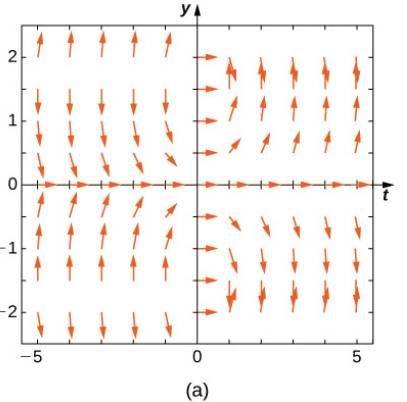
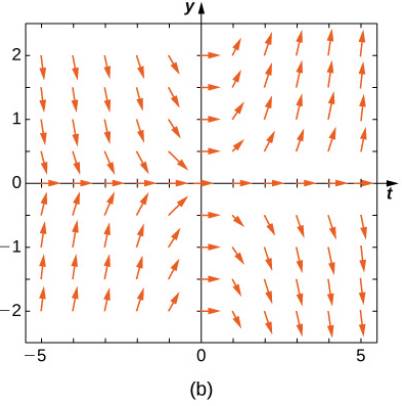
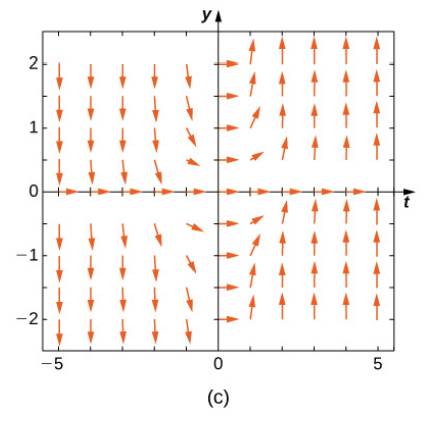
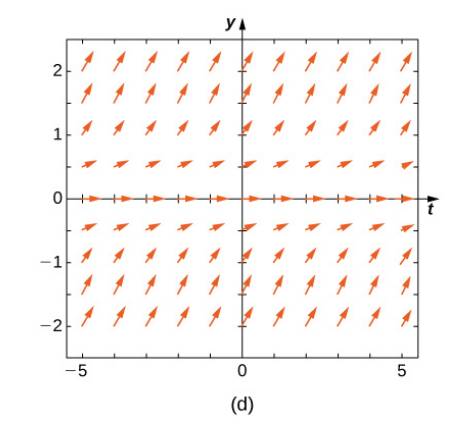
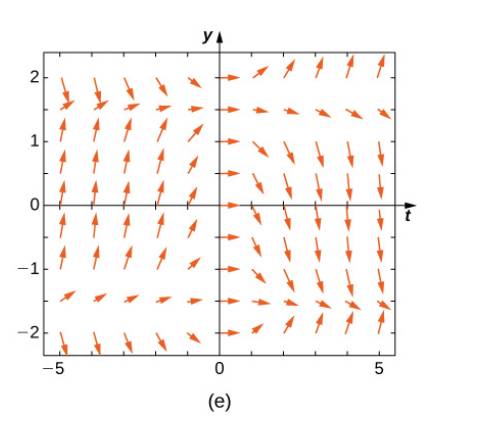
93
Expert Solution & Answer
Want to see the full answer?
Check out a sample textbook solution
Students have asked these similar questions
Shading a Venn diagram with 3 sets: Unions, intersections, and...
The Venn diagram shows sets A, B, C, and the universal set U.
Shade (CUA)' n B on the Venn diagram.
U
Explanation
Check
A-
B
Q Search
田
3. A different 7-Eleven has a bank of slurpee fountain heads. Their available flavors are as follows: Mountain
Dew, Mountain Dew Code Red, Grape, Pepsi and Mountain Dew Livewire. You fill five different cups full
with each type of flavor. How many different ways can you arrange the cups in a line if exactly two Mountain
Dew flavors are next to each other?
3.2.1
Business
Chapter 4 Solutions
Calculus Volume 2
Ch. 4.1 - Determine the order of the following differential...Ch. 4.1 - Determine the order of the following differential...Ch. 4.1 - Determine the order of the following differential...Ch. 4.1 - Determine the order of the following differential...Ch. 4.1 - Determine the order of the following differential...Ch. 4.1 - Determine the order of the following differential...Ch. 4.1 - Determine the order of the following differential...Ch. 4.1 - Verify that the following functions are solutions...Ch. 4.1 - Verify that the following functions are solutions...Ch. 4.1 - Verify that the following functions are solutions...
Ch. 4.1 - Verify that the following functions are solutions...Ch. 4.1 - Verify that the following functions are solutions...Ch. 4.1 - Verify that the following functions are solutions...Ch. 4.1 - Verify that the following functions are solutions...Ch. 4.1 - Verify that the following functions are solutions...Ch. 4.1 - Verify that the following functions are solutions...Ch. 4.1 - Verify that the following functions are solutions...Ch. 4.1 - Verify the following general solutions and find...Ch. 4.1 - Verify the following general solutions and find...Ch. 4.1 - Verify the following general solutions and find...Ch. 4.1 - Verify the following general solutions and find...Ch. 4.1 - Verify the following general solutions and find...Ch. 4.1 - Verify the following general solutions and find...Ch. 4.1 - Verify the following general solutions and find...Ch. 4.1 - Verify the following general solutions and find...Ch. 4.1 - Verify the following general solutions and find...Ch. 4.1 - Verify the following general solutions and find...Ch. 4.1 - For the following problems, find the general...Ch. 4.1 - For the following problems, find the general...Ch. 4.1 - For the following problems, find the general...Ch. 4.1 - For the following problems, find the general...Ch. 4.1 - For the following problems, find the general...Ch. 4.1 - For the following problems, find the general...Ch. 4.1 - For the following problems, find the general...Ch. 4.1 - For the following problems, find the general...Ch. 4.1 - For the following problems, find the general...Ch. 4.1 - For the following problems, find the general...Ch. 4.1 - Solve the following initial-value problems...Ch. 4.1 - Solve the following initial-value problems...Ch. 4.1 - Solve the following initial-value problems...Ch. 4.1 - Solve the following initial-value problems...Ch. 4.1 - Solve the following initial-value problems...Ch. 4.1 - Solve the following initial-value problems...Ch. 4.1 - Solve the following initial-value problems...Ch. 4.1 - Solve the following initial-value problems...Ch. 4.1 - Solve the following initial-value problems...Ch. 4.1 - Solve the following initial-value problems...Ch. 4.1 - Recall that a family of solutions includes...Ch. 4.1 - Recall that a family of solutions includes...Ch. 4.1 - Recall that a family of solutions includes...Ch. 4.1 - Recall that a family of solutions includes...Ch. 4.1 - Recall that a family of solutions includes...Ch. 4.1 - Recall that a family of solutions includes...Ch. 4.1 - Recall that a family of solutions includes...Ch. 4.1 - Recall that a family of solutions includes...Ch. 4.1 - Recall that a family of solutions includes...Ch. 4.1 - Recall that a family of solutions includes...Ch. 4.1 - Recall that a family of solutions includes...Ch. 4.1 - Recall that a family of solutions includes...Ch. 4.1 - Recall that a family of solutions includes...Ch. 4.1 - Recall that a family of solutions includes...Ch. 4.1 - Recall that a family of solutions includes...Ch. 4.1 - Recall that a family of solutions includes...Ch. 4.1 - Recall that a family of solutions includes...Ch. 4.1 - Recall that a family of solutions includes...Ch. 4.2 - For the following problems, use the direction...Ch. 4.2 - For the following problems, use the direction...Ch. 4.2 - For the following problems, use the direction...Ch. 4.2 - For the following problems, use the direction...Ch. 4.2 - For the following problems, use the direction...Ch. 4.2 - For the following problems, use the direction...Ch. 4.2 - For the following problems, use the direction...Ch. 4.2 - For the following problems, use the direction...Ch. 4.2 - Draw the direction field for the following...Ch. 4.2 - Draw the direction field for the following...Ch. 4.2 - Draw the direction field for the following...Ch. 4.2 - Draw the direction field for the following...Ch. 4.2 - Draw the direction field for the following...Ch. 4.2 - Draw the directional field for the following...Ch. 4.2 - Draw the directional field for the following...Ch. 4.2 - Draw the directional field for the following...Ch. 4.2 - Draw the directional field for the following...Ch. 4.2 - Draw the directional field for the following...Ch. 4.2 - Match the direction field with the given...Ch. 4.2 - Match the direction field with the given...Ch. 4.2 - Match the direction field with the given...Ch. 4.2 - Match the direction field with the given...Ch. 4.2 - Match the direction field with the given...Ch. 4.2 - Match the direction field with the given...Ch. 4.2 - Match the direction field with the given...Ch. 4.2 - Match the direction field with the given...Ch. 4.2 - Match the direction field with the given...Ch. 4.2 - Match the direction field with the given...Ch. 4.2 - Estimate the following solutions using Euler’s...Ch. 4.2 - Estimate the following solutions using Euler’s...Ch. 4.2 - WEstimate the following solutions using Euler’s...Ch. 4.2 - Estimate the following solutions using Euler’s...Ch. 4.2 - Estimate the following solutions using Euler’s...Ch. 4.2 - Estimate the following solutions using Euler’s...Ch. 4.2 - Estimate the following solutions using Euler’s...Ch. 4.2 - Estimate the following solutions using Euler’s...Ch. 4.2 - Estimate the following solutions using Euler’s...Ch. 4.2 - Estimate the following solutions using Euler’s...Ch. 4.2 - Differential equations can be used to model...Ch. 4.2 - Differential equations can be used to model...Ch. 4.2 - Differential equations can be used to model...Ch. 4.2 - Differential equations can be used to model...Ch. 4.2 - Differential equations can be used to model...Ch. 4.2 - Differential equations can be used to model...Ch. 4.2 - Differential equations can be used to model...Ch. 4.2 - Differential equations can be used to model...Ch. 4.2 - Differential equations can be used to model...Ch. 4.2 - Differential equations can be used to model...Ch. 4.2 - Consider the initial-value problem y' = 2y, y(0) =...Ch. 4.2 - Consider the initial-value problem y' = 2y, y(0) =...Ch. 4.2 - Consider the initial-value problem y' = 2y, y(0) =...Ch. 4.2 - Consider the initial-value problem y' = 2y, y(0) =...Ch. 4.2 - Consider the initial-value problem y' = 2y, y(0) =...Ch. 4.3 - Solve the following initial-value problems with...Ch. 4.3 - Solve the following initial-value problems with...Ch. 4.3 - Solve the following initial-value problems with...Ch. 4.3 - Solve the following initial-value problems with...Ch. 4.3 - Find the general solution to the differential...Ch. 4.3 - Find the general solution to the differential...Ch. 4.3 - Find the general solution to the differential...Ch. 4.3 - Find the general solution to the differential...Ch. 4.3 - Find the general solution to the differential...Ch. 4.3 - Find the general solution to the differential...Ch. 4.3 - Find the general solution to the differential...Ch. 4.3 - Find the general solution to the differential...Ch. 4.3 - Find the general solution to the differential...Ch. 4.3 - Find the general solution to the differential...Ch. 4.3 - Find the solution to the initial-value problem....Ch. 4.3 - Find the solution to the initial-value problem....Ch. 4.3 - Find the solution to the initial-value problem....Ch. 4.3 - Find the solution to the initial-value problem....Ch. 4.3 - Find the solution to the initial-value problem....Ch. 4.3 - Find the solution to the initial-value problem....Ch. 4.3 - Find the solution to the initial-value problem....Ch. 4.3 - Find the solution to the initial-value problem....Ch. 4.3 - Find the solution to the initial-value problem....Ch. 4.3 - Find the solution to the initial-value problem....Ch. 4.3 - For the following problems, use a software program...Ch. 4.3 - For the following problems, use a software program...Ch. 4.3 - For the following problems, use a software program...Ch. 4.3 - For the following problems, use a software program...Ch. 4.3 - For the following problems, use a software program...Ch. 4.3 - Most drugs in the bloodstream decay according to...Ch. 4.3 - A drug is administered intravenously to a patient...Ch. 4.3 - [T] How often should a drug be taken if its dose...Ch. 4.3 - A tank contains 1 kilogram of salt dissolved in...Ch. 4.3 - A tank containing 10 kilograms of salt dissolved...Ch. 4.3 - [T] For the preceding problem, find flow much salt...Ch. 4.3 - Torricelli’s law states that for a water tank with...Ch. 4.3 - For the preceding problem, determine how long it...Ch. 4.3 - For the following problems, use Newton’s law of...Ch. 4.3 - For the following problems, use Newton’s law of...Ch. 4.3 - For the following problems, use Newton’s law of...Ch. 4.3 - For the following problems, use Newton’s law of...Ch. 4.3 - For the following problems, use Newton’s law of...Ch. 4.3 - For the following problems, use Newton’s law of...Ch. 4.3 - For the following problems, use Newton’s law of...Ch. 4.3 - For the following problems, use Newton’s law of...Ch. 4.3 - For the following problems, use Newton’s law of...Ch. 4.3 - For the following problems, use Newton’s law of...Ch. 4.3 - For the following problems, use Newton’s law of...Ch. 4.3 - For the following problems, use Newton’s law of...Ch. 4.4 - Student Project: Logistic Equation with a...Ch. 4.4 - Student Project: Logistic Equation with a...Ch. 4.4 - Student Project: Logistic Equation with a...Ch. 4.4 - Student Project: Logistic Equation with a...Ch. 4.4 - For the following problems, consider the logistic...Ch. 4.4 - For the following problems, consider the logistic...Ch. 4.4 - For the following problems, consider the logistic...Ch. 4.4 - For the following problems, consider the logistic...Ch. 4.4 - For the following problems, consider the logistic...Ch. 4.4 - A population of deer inside a park has a carrying...Ch. 4.4 - A population of frogs in a pond has a growth rate...Ch. 4.4 - [T] Bacteria grow at a rate of 2O per hour in a...Ch. 4.4 - [T] Rabbits in a park have an initial population...Ch. 4.4 - [T] Two monkeys are placed on an island. After 5...Ch. 4.4 - [T] A butterfly sanctuary is built that can hold...Ch. 4.4 - The following problems consider the logistic...Ch. 4.4 - The following problems consider the logistic...Ch. 4.4 - The following problems consider the logistic...Ch. 4.4 - The following problems consider the logistic...Ch. 4.4 - The following problems consider the logistic...Ch. 4.4 - It is more likely that the amount of fishing is...Ch. 4.4 - It is more likely that the amount of fishing is...Ch. 4.4 - It is more likely that the amount of fishing is...Ch. 4.4 - It is more likely that the amount of fishing is...Ch. 4.4 - It is more likely that the amount of fishing is...Ch. 4.4 - The following problems add in a minimal threshold...Ch. 4.4 - The following problems add in a minimal threshold...Ch. 4.4 - The following problems add in a minimal threshold...Ch. 4.4 - The following problems add in a minimal threshold...Ch. 4.4 - The following problems add in a minimal threshold...Ch. 4.4 - The following questions consider the Gompertz...Ch. 4.4 - The following questions consider the Gompertz...Ch. 4.4 - The following questions consider the Gompertz...Ch. 4.4 - The following questions consider the Gompertz...Ch. 4.4 - The following questions consider the Gompertz...Ch. 4.4 - The following questions consider the Gompertz...Ch. 4.4 - The following questions consider the Gompertz...Ch. 4.4 - The following questions consider the Gompertz...Ch. 4.4 - The following questions consider the Gompertz...Ch. 4.4 - Below is a table of the populations of whooping...Ch. 4.4 - Below is a table of the populations of whooping...Ch. 4.4 - Below is a table of the populations of whooping...Ch. 4.4 - Below is a table of the populations of whooping...Ch. 4.4 - Below is a table of the populations of whooping...Ch. 4.5 - Are the following differential equations linear?...Ch. 4.5 - Are the following differential equations linear?...Ch. 4.5 - Are the following differential equations linear?...Ch. 4.5 - Are the following differential equations linear?...Ch. 4.5 - Are the following differential equations linear?...Ch. 4.5 - Write the following first-order differential...Ch. 4.5 - Write the following first-order differential...Ch. 4.5 - Write the following first-order differential...Ch. 4.5 - Write the following first-order differential...Ch. 4.5 - Write the following first-order differential...Ch. 4.5 - What are the integrating factors for the following...Ch. 4.5 - What are the integrating factors for the following...Ch. 4.5 - What are the integrating factors for the following...Ch. 4.5 - What are the integrating factors for the following...Ch. 4.5 - What are the integrating factors for the following...Ch. 4.5 - Solve the following differential equations by...Ch. 4.5 - Solve the following differential equations by...Ch. 4.5 - Solve the following differential equations by...Ch. 4.5 - Solve the following differential equations by...Ch. 4.5 - Solve the following differential equations by...Ch. 4.5 - Solve the following differential equations by...Ch. 4.5 - Solve the following differential equations by...Ch. 4.5 - Solve the following differential equations by...Ch. 4.5 - Solve the following differential equations by...Ch. 4.5 - Solve the following differential equations by...Ch. 4.5 - Solve the following differential equations. Use...Ch. 4.5 - Solve the following differential equations. Use...Ch. 4.5 - Solve the following differential equations. Use...Ch. 4.5 - Solve the following differential equations. Use...Ch. 4.5 - Solve the following differential equations. Use...Ch. 4.5 - Solve the following differential equations. Use...Ch. 4.5 - Solve the following differential equations. Use...Ch. 4.5 - Solve the following differential equations. Use...Ch. 4.5 - Solve the following initial-value problems by...Ch. 4.5 - Solve the following initial-value problems by...Ch. 4.5 - Solve the following initial-value problems by...Ch. 4.5 - Solve the following initial-value problems by...Ch. 4.5 - Solve the following initial-value problems by...Ch. 4.5 - Solve the following initial-value problems by...Ch. 4.5 - Solve the following initial-value problems by...Ch. 4.5 - Solve the following initial-value problems by...Ch. 4.5 - Solve the following initial-value problems by...Ch. 4.5 - Solve the following initial-value problems by...Ch. 4.5 - A falling object of mass m can reach terminal...Ch. 4.5 - Using your expression from the preceding problem,...Ch. 4.5 - [T] Using your equation for terminal velocity,...Ch. 4.5 - A more accurate way to describe terminal velocity...Ch. 4.5 - Using your expression from the preceding problem,...Ch. 4.5 - [T] Using your equation for terminal velocity,...Ch. 4.5 - For the following problems, determine how...Ch. 4.5 - For the following problems, determine how...Ch. 4.5 - For the following problems, determine how...Ch. 4.5 - For the following problems, determine how...Ch. 4.5 - For the following problems, determine how...Ch. 4 - True or False? Justify your answer with a proof or...Ch. 4 - True or False? Justify your answer with a proof or...Ch. 4 - True or False? Justify your answer with a proof or...Ch. 4 - True or False? Justify your answer with a proof or...Ch. 4 - For the following problems, find the general...Ch. 4 - For the following problems, find the general...Ch. 4 - For the following problems, find the general...Ch. 4 - For the following problems, find the general...Ch. 4 - For the following problems, find the general...Ch. 4 - For the following problems, find the general...Ch. 4 - For the following problems, find the solution to...Ch. 4 - For the following problems, find the solution to...Ch. 4 - For the following problems, find the solution to...Ch. 4 - For the following problems, find the solution to...Ch. 4 - For the following problems, find the solution to...Ch. 4 - For the following problems, find the solution to...Ch. 4 - For the following problems, draw the directional...Ch. 4 - For the following problems, draw the directional...Ch. 4 - For the following problems, use Euler’s Method...Ch. 4 - For the following problems, use Euler’s Method...Ch. 4 - For the following problems, set up and solve the...Ch. 4 - For the following problems, set up and solve the...Ch. 4 - For the following problems, set up and solve the...Ch. 4 - For the following problems, set up and solve the...Ch. 4 - For the following problems, set up and solve the...Ch. 4 - For the following problems, set up and solve the...Ch. 4 - For the following problems, set up and solve the...Ch. 4 - For the following problems, set up and solve the...Ch. 4 - For the following problems, set up and solve the...
Additional Math Textbook Solutions
Find more solutions based on key concepts
CHECK POINT 1 Write a word description of the set L = {a, b, c, d, e, f}.
Thinking Mathematically (6th Edition)
A pair of fair dice is rolled. What is the probability that the second die lands on a higher value than does th...
A First Course in Probability (10th Edition)
Optimal garden A rectangular flower garden with an area of 30 m2 is surrounded by a grass border 1 m wide on tw...
Calculus: Early Transcendentals (2nd Edition)
ASSESSMENT A sheet of paper is cut into 5 same-size parts. Each of the parts is then cut into 5 same-size parts...
A Problem Solving Approach To Mathematics For Elementary School Teachers (13th Edition)
Knowledge Booster
Learn more about
Need a deep-dive on the concept behind this application? Look no further. Learn more about this topic, subject and related others by exploring similar questions and additional content below.Similar questions
- Please explain how come of X2(n).arrow_forwardNo chatgpt pls will upvotearrow_forwardFind all solutions of the polynomial congruence x²+4x+1 = 0 (mod 143). (The solutions of the congruence x² + 4x+1=0 (mod 11) are x = 3,4 (mod 11) and the solutions of the congruence x² +4x+1 = 0 (mod 13) are x = 2,7 (mod 13).)arrow_forward
- https://www.hawkeslearning.com/Statistics/dbs2/datasets.htmlarrow_forwardDetermine whether each function is an injection and determine whether each is a surjection.The notation Z_(n) refers to the set {0,1,2,...,n-1}. For example, Z_(4)={0,1,2,3}. f: Z_(6) -> Z_(6) defined by f(x)=x^(2)+4(mod6). g: Z_(5) -> Z_(5) defined by g(x)=x^(2)-11(mod5). h: Z*Z -> Z defined by h(x,y)=x+2y. j: R-{3} -> R defined by j(x)=(4x)/(x-3).arrow_forwardDetermine whether each function is an injection and determine whether each is a surjection.arrow_forward
- Let A = {a, b, c, d}, B = {a,b,c}, and C = {s, t, u,v}. Draw an arrow diagram of a function for each of the following descriptions. If no such function exists, briefly explain why. (a) A function f : AC whose range is the set C. (b) A function g: BC whose range is the set C. (c) A function g: BC that is injective. (d) A function j : A → C that is not bijective.arrow_forwardLet f:R->R be defined by f(x)=x^(3)+5.(a) Determine if f is injective. why?(b) Determine if f is surjective. why?(c) Based upon (a) and (b), is f bijective? why?arrow_forwardLet f:R->R be defined by f(x)=x^(3)+5.(a) Determine if f is injective.(b) Determine if f is surjective. (c) Based upon (a) and (b), is f bijective?arrow_forward
arrow_back_ios
SEE MORE QUESTIONS
arrow_forward_ios
Recommended textbooks for you
 Discrete Mathematics and Its Applications ( 8th I...MathISBN:9781259676512Author:Kenneth H RosenPublisher:McGraw-Hill Education
Discrete Mathematics and Its Applications ( 8th I...MathISBN:9781259676512Author:Kenneth H RosenPublisher:McGraw-Hill Education Mathematics for Elementary Teachers with Activiti...MathISBN:9780134392790Author:Beckmann, SybillaPublisher:PEARSON
Mathematics for Elementary Teachers with Activiti...MathISBN:9780134392790Author:Beckmann, SybillaPublisher:PEARSON
 Thinking Mathematically (7th Edition)MathISBN:9780134683713Author:Robert F. BlitzerPublisher:PEARSON
Thinking Mathematically (7th Edition)MathISBN:9780134683713Author:Robert F. BlitzerPublisher:PEARSON Discrete Mathematics With ApplicationsMathISBN:9781337694193Author:EPP, Susanna S.Publisher:Cengage Learning,
Discrete Mathematics With ApplicationsMathISBN:9781337694193Author:EPP, Susanna S.Publisher:Cengage Learning, Pathways To Math Literacy (looseleaf)MathISBN:9781259985607Author:David Sobecki Professor, Brian A. MercerPublisher:McGraw-Hill Education
Pathways To Math Literacy (looseleaf)MathISBN:9781259985607Author:David Sobecki Professor, Brian A. MercerPublisher:McGraw-Hill Education

Discrete Mathematics and Its Applications ( 8th I...
Math
ISBN:9781259676512
Author:Kenneth H Rosen
Publisher:McGraw-Hill Education

Mathematics for Elementary Teachers with Activiti...
Math
ISBN:9780134392790
Author:Beckmann, Sybilla
Publisher:PEARSON


Thinking Mathematically (7th Edition)
Math
ISBN:9780134683713
Author:Robert F. Blitzer
Publisher:PEARSON

Discrete Mathematics With Applications
Math
ISBN:9781337694193
Author:EPP, Susanna S.
Publisher:Cengage Learning,

Pathways To Math Literacy (looseleaf)
Math
ISBN:9781259985607
Author:David Sobecki Professor, Brian A. Mercer
Publisher:McGraw-Hill Education
01 - What Is A Differential Equation in Calculus? Learn to Solve Ordinary Differential Equations.; Author: Math and Science;https://www.youtube.com/watch?v=K80YEHQpx9g;License: Standard YouTube License, CC-BY
Higher Order Differential Equation with constant coefficient (GATE) (Part 1) l GATE 2018; Author: GATE Lectures by Dishank;https://www.youtube.com/watch?v=ODxP7BbqAjA;License: Standard YouTube License, CC-BY
Solution of Differential Equations and Initial Value Problems; Author: Jefril Amboy;https://www.youtube.com/watch?v=Q68sk7XS-dc;License: Standard YouTube License, CC-BY